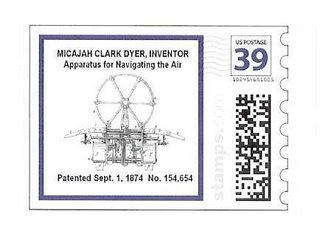 To view the source site for this and more news articles on Micajah Clark Dyer, click here.
To view the source site for this and more news articles on Micajah Clark Dyer, click here.
Micajah Clark Dyer (1822-1891) has been nominated for induction into the Georgia Aviation Hall of Fame at Dobbins Air Force Base in Warner Robins, Georgia. The nomination is based on Dyer's invention of an "Apparatus for Navigating the Air" for which he received U.S. Patent No. 154,654 on September 1, 1874. The story leading up this nomination is an amazing one.
Clark (as he was called) lived in the Choestoe district of Union County, Georgia, right at the foot of Rattlesnake and Cedar Mountains. He was a uniquely intelligent man and built a gristmill on Stink Creek where he ground his and the neighbors' corn. He hollowed out logs and piped water into his house, giving him the distinction of being the only resident in the community to have running water. He was always working on some new technique or invention in the shop in back of his house. Some of his neighbors thought he was a kook to spend so much time tinkering on gadgets that didn't seem to them to be worth anything. Their unkind remarks caused him to become very secretive about his creations, and he kept his shop locked, shielding his work from their prying eyes.
His work on the remarkable invention began in the mid-1800's when he was just a young man in his twenties with a growing family to support. As he watched the birds flying over his farm he wondered, why can't a man fly? His education had not advanced beyond the little one-room school in his community. He was a poor farmer, with only primitive tools for building things. Yet, all of us in the Dyer family knew from the story that had been handed down for more than a hundred years that he designed, built and flew a crude airplane right off the side of Rattlesnake Mountain. According to legend, the family and neighbors actually saw him navigate the craft over his fields. He reportedly applied for a patent for the machine, and it was believed that after his death in 1891 his widow sold both the contraption and the plans to some brothers named Redwine. The family still firmly believes that those items eventually wound up in the hands of the Wright brothers, who were credited with making the first manned flight in 1903.
In 1980, Kenneth Akins, great-great-great grandson of Clark Dyer and a teacher at Union County High School, became very interested in knowing whether the family legend could be verified. He teamed up with another historian, Robert Davis, and they searched records, interviewed all of the elderly residents of Choestoe, and tried to find as many facts as possible about the flying machine. They wound up with many verbal testimonies from credible people, and they were convinced that the story was true, but they could not find a patent or any contemporaneously written report about the remarkable invention. The Times, a Gainesville, Georgia, newspaper, published a story about their findings on March 16, 1980, with the headline "Not everyone believes Wright brothers first."
It appeared that we would never find any documentary proof that my great-great grandfather built and flew an airplane here in the North Georgia Mountains almost 30 years before the Wright Brothers flew theirs. Then, in 2004, a young man named Joey, one of Clark Dyer's descendants, typed in "Micajah Clark Dyer patent" on Google, followed the links, and succeeded in accessing the patent in the U. S. Patent Office files. There is was: Patent No. 154,654 issued to Micajah Clark Dyer of Blairsville, Ga. on September 1, 1874, for an "Apparatus for Navigating the Air." The drawings and specifications looked like something an engineering PhD. had drawn up! The aeronautical principles he had addressed were way ahead of anything that had yet been envisioned by others trying to invent a flying machine. Later, we found two newspaper stories that were published in 1875 about the invention, one in the Gainesville (Ga.) Eagle and the other in the St. Louis Globe-Democrat. But, obviously, there was not enough publicity to cause Clark Dyer to be included in the history books. I knew we had to get public recognition for this man's accomplishments, and I set about to do whatever I could to see that he would get credit now.
At my request, State Representative Charles Jenkins introduced legislation during the 2006 legislative session of the Georgia General Assembly to name State Highway 180 from the junction of U.S. Highway 19/129 to the Brasstown Bald Mountain Spur the "Micajah Clark Dyer Parkway." The House and Senate ultimately passed the Resolution unanimously, and the Governor signed it on April 28, 2006. On July 15, 2006, the road sign was unveiled at a well-attended ceremony. Publicity about the road sign aroused interest from a number of places, and on August 6, 2006, The Times, Gainesville, Georgia, published a front page story in their local news section. A number of newspapers across the country picked up the story through the Associated Press and published it also.
The Curator of the Georgia Aviation Hall of Fame heard about the story, and she called me to express an interest in including Clark Dyer in Georgia's 100th Anniversary of Flying ceremonies to take place in April 2007. She requested that I send her information on the invention, which I was happy to do. This ultimately led to a formal nomination of Clark for induction into the Georgia Aviation Hall of Fame. The Hall of Fame Board of Electors will select the inductees from the group of qualified nominees submitted during the year, and hopefully Micajah Clark Dyer will take his rightful place of honor in the Hall.
 Back to Top
Back to Top  Home
Home





